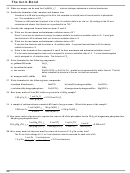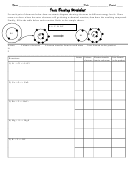The Ionic Bond Worksheet
ADVERTISEMENT
Chapter 4
The Ionic Bond
1. Define the term “isoelectronic”.
Two atoms are isoelectronic when they have the same electron configuration.
Which of the following compounds are ionic?
3.
KCN
HNO
CoPO
NH
NO
a)
b)
c)
d)
2
4
4
2
Ionic compounds contain either a metal or the ammonium ion, so a, c and d are ionic.
5. How can the number of electrons involved in metals and nonmetals achieving noble gas configurations be predicted
for the main group (A Groups) elements?
The number of electrons gained by a nonmetal is eight minus its group number. The number lost by a metal is
equal to its group number.
7. Oxygen can have a positive oxidation state when bound to only one element. What is the element? Use orbital
energies to explain why this is so.
Fluorine in the only element with priority over oxygen that forms a negative ion. When O and F bond, F is –1,
so O must be positive. The compound they form is OF
, in which case the O is +2. The reason is that fluorine
2
is the only element that is more electronegative, which means that its valence orbitals are lower in energy than
those on O. Consequently, the bonding electrons are assigned to the fluorine when assigning oxidation states.
Which element in each pair that would have the positive oxidation state.
9.
N & O
Cl & P
S & Sn
K & N
a)
b)
c)
d)
The less electronegative element will have the positive oxidation state: N, P, Sn, and K
11. Write electron configurations for the following ions. Use the noble gas core abbreviations.
2+
3+
10
a) Ca
b) Ga
[Ar]
[Ar] 3d
3+
1-
6
c) Co
d) I
[Ar] 3d
[Xe]
13. Explain the following observations.
1+
1+
a) K
is larger than Na
.
The size of the ions in a group increases going down the group because the n quantum number of the
outermost electrons increases.
1+
1-
.
b) Na is larger than Cl, but Na
is much smaller than Cl
Na is larger than Cl because the effective nuclear charge experienced by the valence electrons is greater for
1+
1-
Cl. Na
is isoelectronic with Ne and slightly smaller due to the additional proton while Cl
is isoelectronic
with Ar, but it is slightly larger because Ar has one more proton, which increases its effective nuclear charge.
c) Lead forms two oxides, PbO and PbO
.
2
2
2
Lead’s valence electron configuration is 6s
6p
. It can lose the two 6p electrons to form a +2 ion as in PbO or
it can lose all four to achieve the +4 oxidation state as in PbO
2
15. Determine the oxidation state of the underlined atom.
a) C
C
is an element and all atoms are therefore in the 0 oxidation state.
60
60
b) LiAlH
Al has priority of H and is assigned a +3 oxidation state. Li is a +1, which means that H is -1. This
4
compound is therefore a hydride, lithium aluminum hydride.
c) OF
F is always -1 in its compounds with other elements so O is a +2 in this compound.
2
d) CaSiO
Ca is +2 and O is -2. +2 + y + 3(-2) = 0, so y = +4. This is calcium silicate.
3
17. Name the following compounds:
a) Zn
(PO
)
zinc phosphate. Because the d sublevel is full for Zn, it forms only the +2 ion.
3
4
2
b) Ag
S
silver sulfide. Silver is an exception to the rules for transition metals and only forms +1 ions.
2
c) Cr
O
chromium(III) oxide. Chromium is a typical transition metal and adopts many oxidation states.
2
3
d) NH
Cl
ammonium chloride.
4
4-1
ADVERTISEMENT
0 votes
Related Articles
Related forms
Related Categories
Parent category: Education
 1
1 2
2








